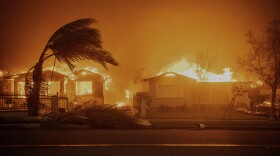Following an exhaustive, costly and highly hazardous four-day firefighting effort, an explosive blaze that heavily damaged the USS Bonhomme Richard at Naval Base San Diego was believed to be fully extinguished Thursday.
As of early afternoon, "all known fires" on the 27,565-ton warship were out, Rear Adm. Philip Sobeck announced.
"Our fire teams are investigating every space to verify the absence of fire," Sobeck said in a prepared statement.
That process will have to conclude prior to the start of an official inquiry into what caused the conflagration, how much damage it did and "what the future of the ship will be," the admiral noted.
"We cannot make any conclusions until the investigation is complete," he said.
A total of 40 sailors and 23 civilian firefighters suffered various minor injuries, mostly heat exhaustion and smoke inhalation while taking part in the out-out battle to defeat the blaze, according to Navy officials.
The fire erupted shortly before 9 a.m. Sunday in a part of the vessel where cardboard and tri-wall boxes are kept, and soon was sending thick columns of acrid smoke above the bay and across much of the city. There were 160 sailors and officers aboard the ship when the fire broke out, Navy spokesman Brian O'Rourke said.
Because the ship was undergoing maintenance work when the fire erupted, its built-in flame-suppression system was inoperative, according to base officials.
After about 90 minutes, authorities decided to remove all firefighters from the vessel for safety reasons and go after the blaze by remote means, including helicopters and fireboats surrounding it on the bay.
San Diegans affected by air pollution from the USS Bonhomme Richard fire are eligible for temporary relocation relief.
— Kevin Faulconer (@Kevin_Faulconer) July 16, 2020
Residents in 91950, 92113 and 92102 zip codes can apply for a 2-night hotel stay valid for July 15 & 16. To apply and get more information call 2-1-1. pic.twitter.com/wxCyUAy8Ez
About two hours after the fire began, a blast of unknown origin shook the vessel and "threw several firefighters off their feet," the San Diego Fire-Rescue Department reported.
The inferno eventually sent below-deck temperatures as high as 1,000 degrees and left the ship listing due to the amount of water it had taken on from the firefighting efforts, Navy officials said.
About four hours after the ship began burning, the Navy moved the USS Fitzgerald and USS Russell to berths farther away from the fire, according to Mike Raney, deputy public affairs officer with the Naval Surface Force.
As military and civilian crews made progress in quelling the inferno, Navy officials were able to determine that the 22-year-old ship had escaped complete destruction.
"First, we have investigated the four main engineering spaces (of the ship) and found no major damage," Rear Adm. Philip Sobeck told reporters Tuesday during a briefing at the naval base south of downtown San Diego. "There is no threat to the fuel tanks, which (are) well below any active fires or heat sources. The ship is stable, and (its) structure is safe."
Authorities again evacuated all personnel from the ship late Wednesday night "out of an abundance of caution" because it had begun to shift to one side, Navy officials said. By 6 this morning, the vessel had stabilized, and firefighters reboarded to continue attacking the blaze.
As of Wednesday morning, flight personnel had conducted more than 1,500 helicopter water drops on the ship, a process that was "cooling the superstructure and flight deck, enabling fire crews to get onboard internally to fight the fire," Navy officials said.
Three helicopter squadrons conducted more than 1,500 water-bucket drops, helping cool its superstructure and flight deck, while tugboats blasted the smoking warship with water cannons.
Among the precautions in the area of the blaze instituted by the U.S. Coast Guard were a one-nautical-mile safety zone on the waters surrounding the ship and up to 3,000 feet in the air above it. Users of neighboring marinas were being advised to "utilize protective safety measures" as well, according to the agency.
USCG personnel also were assessing "environmental sensitivities and has contracted an oil-spill response organization to preemptively deploy protective boom to guard against any potential environmental concerns," according to a Coast Guard statement.
The Navy, for its part, will "work together with regulators, (and the) county and state in protecting our environment and preparing to address the community's concerns as we move forward to the next phase," Sobeck said.
Officials in National City, just south of the site of the fire, asked residents to remain in their homes as much as possible to avoid health hazards from the smoke billowing off the burning vessel. Likewise, the San Diego County Air Pollution Control District Office noted that if residents can smell acrid smoke, they should limit physical activity and stay indoors if possible.
This morning, San Diego City Council President Georgette Gomez announced that some residents in the 92102, 92113 and 91950 ZIP codes who have been bothered by pollution from the fire could get one-night hotel vouchers, though availability was limited and prioritized to people with relevant health problems. Interested parties were asked to call the city's 211 community- services telephone line.
The Bonhomme Richard is the third warship in U.S. naval history to bear the name, which means "Good Man Richard" in French and honors Benjamin Franklin's "Poor Richard's Almanac."
The vessel has been homeported at Naval Base San Diego since the spring of 2018, when it returned from a six-year port switch to Sasebo, Japan, while becoming the command ship for Navy Expeditionary Strike Group Seven.





